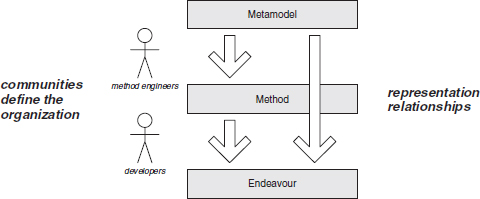6.1 GENERAL PHILOSOPHY AND SCOPE
ISO/IEC 24744 (known as SEMDM) [16] was developed in order to:
- (a) integrate process, product and producer aspects of methodology specification
- (b) provide methodological support in a single package (as opposed to the OMG's separate offerings of UML for product, SPEM for process and nothing for producers)
- (c) fix the double-level transmission challenges found in SPEM, i.e. to support enactment as well as process modelling
- (d) create a higher level description of method that does not require a link to UML (as SPEM does in its UML profile) but at the same time permitting SPEM-like extensions towards UML
- (e) support extensibility but avoid all the problems of the UML stereotyping mechanism (as noted, for example, in [5; 14])
- (f) align the notion of modelling and metamodelling with reality, as opposed to adopting the “artificial” restrictions imposed by strict metamodelling and the use of instance-of relationships between layers rather than a more generic representation relationship [18] (Figure 6.1).

Figure 6.1: Domains aligned with the various communities using the representation relationship
The international standard itself notes that it is widely applicable to “information-based domains” and can be usefully applied to any modelling technology such as objects, agents, components, etc. The metamodel can be readily extended (using supplied mechanisms) ...
Get Metamodelling for Software Engineering now with the O’Reilly learning platform.
O’Reilly members experience books, live events, courses curated by job role, and more from O’Reilly and nearly 200 top publishers.

